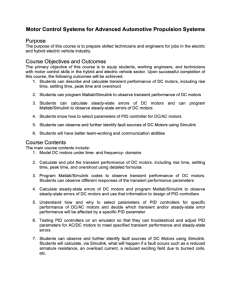Motor Control Systems for Advanced Automotive Propulsion Systems

Course Description:
This Motor Control Systems for Advanced Automotive Propulsion Systems course was developed by Wayne State University through seed funding from the Center for Advanced Automotive Technology.
The purpose of this course is to prepare skilled technicians and engineers for jobs in the electric and hybrid electric vehicle industry.
The primary objective of this course is to equip students, working engineers, and technicians with motor control skills in the hybrid and electric vehicle sector. Upon successful completion of this course, the following outcomes will be achieved: 1) Students can describe and calculate transient performance of DC motors, including rise time, settling time, peak time and overshoot, 2) Students can program Matlab/Simulink to observe transient performance of DC motors, 3) Students can calculate steady-state errors of DC motors and can program Matlab/Simulink to observe steady-state errors of DC motors, 4) Students know how to select parameters of PID controller for DC/AC motors, 5) Students can observe and further identify fault sources of DC Motors using Simulink, and 6) Students will have better team-working and communication abilities.
Course Contents:
The main course contents include: 1) Model DC motors under time and frequency domains, 2) Calculate and plot the transient performance of DC motors, including rise time, settling time, peak time, and overshoot using detailed formulas, 3) Program Matlab/Simulink codes to observe transient performance of DC motors. Students can observe different responses of the transient performance parameters, 4) Calculate steady-state errors of DC motors and program Matlab/Simulink to observe steady-state errors of DC motors and use that information to design of PID controllers, 5) Understand how and why to select parameters of PID controllers for specific performance of DC/AC motors and decide which transient and/or steady-state error performance will be affected by a specific PID parameters, 6) Testing PID controllers on an emulator so that they can troubleshoot and adjust PID parameters for AC/DC motors to meet specified transient performance and steady-state errors, and 7) Students can observe and further identify fault sources of DC Motors using Simulink. Students will calculate, via Simulink, what will happen if a fault occurs such as a reduced armature resistance, an overload current, a reduced exciting field due to burned coils, etc.
The Course Description document contains the course purpose, objectives and outcomes, and course contents. Four course module documents are included, as well as a paper titled "A DC Motor’s Responses to Faults under Simulink Environment."
To view and execute some of the included files, Matlab/Simulink Software is needed.
For orientation purposes, viewers should begin with WSU Motor Controls Course description.pdf, which offers a course description and overview of topics covered.
Below is a list of the files contained within the .zip attachment. The size of each file is included in parenthesis.
Motor Control Systems for Advanced Automotive Propulsion Systems (12 files, 1.4MB)
- Couse Materials
- Fault Paper (Fault.pdf 676 KB)
-
Models of a DC Motor with Loads in Frequency Domain (Motor_Model.pdf 175KB)
-
PID Control for DC Motors (PID_Control.pdf 74KB)
-
Calculate Steady-State Errors of DC Motors (Steady_Error.pdf 192KB)
-
Detailed Formulas for the Transient Performance of the Motors (Transient_Peroformance3.pdf 296KB)
-
WSU Motor Controls Course description (WSU Motor Controls Course description.docx 16KB)
- MatLab-Simulink files
- DC Motor Model (DC_Motor_Model.m 605B)
- PID control (PID_control.m 1KB)
- Steady Error code 1 (Steady_Error_code1.m 1KB)
- Steady Error code 2 (Steady_Error_code2.m 618B)
- Steady Error code 3 (Steady_Error_code3.m 1KB)
- Transient Performance (transient_performance.m 1KB)
About this Resource


Comments